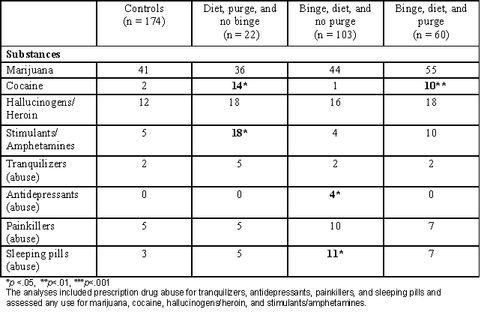Some research suggests a frequent co-occurrence of specific eating disorders and substance use. For example, studies of clinical populations found that bulimics and binge eaters, in particular, relative to anorexic patients or the general population, are more likely to abuse several substances.(Blinder, Cumella, & Sanathara, 2006; Conason, Brunstein Klomek, & Sher, 2006). It is unclear whether this elevated risk also is evident in non-clinical populations, such as community samples. In this week’s STASH, we examine Piran and Robinson’s (2006) study assessing substance use and eating disordered behaviors among female college students.
Five hundred and twenty six female undergraduate students volunteered to participate in the study. Participants were from various racial backgrounds: Caucasian (54%), Asian (29%), another ethnicity (11%), African (3%), Latin/Hispanic (2%), and Native/Aboriginal (1%). Participants completed items from The Women’s Health Survey, which includes items from the Eating Disorder Interview Schedule, Questionnaire for Eating Disorder Diagnoses, and the Young Canadians’ Alcohol and Other Drug Use Survey. The survey also included lifetime specific questions about dieting because of body size or weight concerns, purging (e.g., laxative use or vomiting to control weight or to get rid of food), and eating binges (i.e., eating an unusually large amount of food in a short time and feeling that eating is out of control).
The investigators conducted chi square tests to assess the relationship between eating disorders and substance use, and used the Fisher Exact Probability Test for subsamples less than five. The researchers compared substance use and abuse among participants according to clusters of co-occurring behavior patterns: (1) control (participants who never dieted, purged, or binged); (2) participants who dieted and purged, but never binged; (3) participants who dieted and binged but never purged; and (4) participants who binged, dieted, and purged. (1)

Figure. Percentage of lifetime substance use/abuse among female undergraduate participants with clusters of eating disordered behaviors (N = 359) (Adapted from Piran et al., 2006). Click image to enlarge.
The three most commonly used substances were marijuana (42%), prescription painkillers (25%), and hallucinogens/heroin (14%). According to the study’s results, 28% of the participants reported some form of binging while 37% of the participants reported some dieting. Table 1 shows that participants in the diet, purge, and no binge group reported significant cocaine and stimulant/amphetamine use. Compared to the other groups, the binge, diet, and no purge group reported more antidepressant and sleeping pill abuse (See Table 1). Lastly, participants in the binge, diet, and purge group reported the most cocaine use in comparison to the control group and the other two eating disordered groups.
There are several limitations in the study. Because the data is based on self-report, participants might have underreported both their substance use and eating behaviors, due to the stigma associated with these behaviors. In addition, the results might not be generalizable to all people with eating disorders because this was a female undergraduate sample. There might be other confounding factors involved in this relationship, like peer pressure and college related variables (e.g., age, substance accessibility, stress related to schoolwork), that might have contributed to eating disorders and substance use among this study population. Another limitation is that the study did not uniformly assess criteria for both substance use and substance abuse for all of the substances described in the analyses. For example, researchers assessed abuse of prescription painkiller but only assessed use of substances such as cocaine.
This study suggests that women who have disordered eating behaviors are at risk for substance use and prescription drug abuse. Furthermore, certain eating disorders co-occur with specific types of substance use and abuse. For instance, women who binge and diet may be vulnerable to prescription drug abuse, while women who diet and purge may be vulnerable to amphetamine and stimulant use. Perhaps women who are severe dieters are more at risk to misuse diet related amphetamines and diet pills. Further research about this relationship should closely examine these differences and the motivations behind them. There’s also a need for more research about the severity of these behaviors among other populations. For example, studies should assess whether this relationship exists among women in different age groups or men suffering from eating disorders. More research can better inform intervention programs, for both eating disorders and substance use, about individuals most susceptible to this dangerous cooccurrence of disordered behaviors. Similarly, treatment programs should consider this comorbidity when providing services to clients with eating disorders and substance abuse problems.
What do you think? Please use the comment link below to provide feedback on this article.
________________
[1] The researchers also compared substance use among participants grouped according to eating behaviors: control (participants who never binged, dieted, or purged), binge only (participants who binged but never dieted or purged), and severe diet only (participants dieted daily for at least a month but never binged or purged).
References
Blinder, B. J., Cumella, E. J., & Sanathara, V. A. (2006). Psychiatric Comorbidities of Female Inpatients With Eating Disorders. Psychosomatic Medicine, 68(3), 454-462.
Conason, A. H., Brunstein Klomek, A., & Sher, L. (2006). Recognizing alcohol and drug abuse in patients with eating disorders. Quarterly Journal of Medicine, 99(5), 335-339.
Piran, N., & Robinson, S. R. (2006). Associations between disordered eating behaviors and licit and illicit substance use and abuse in a university sample. Addictive Behaviors, 31(10), 1761-1775.




